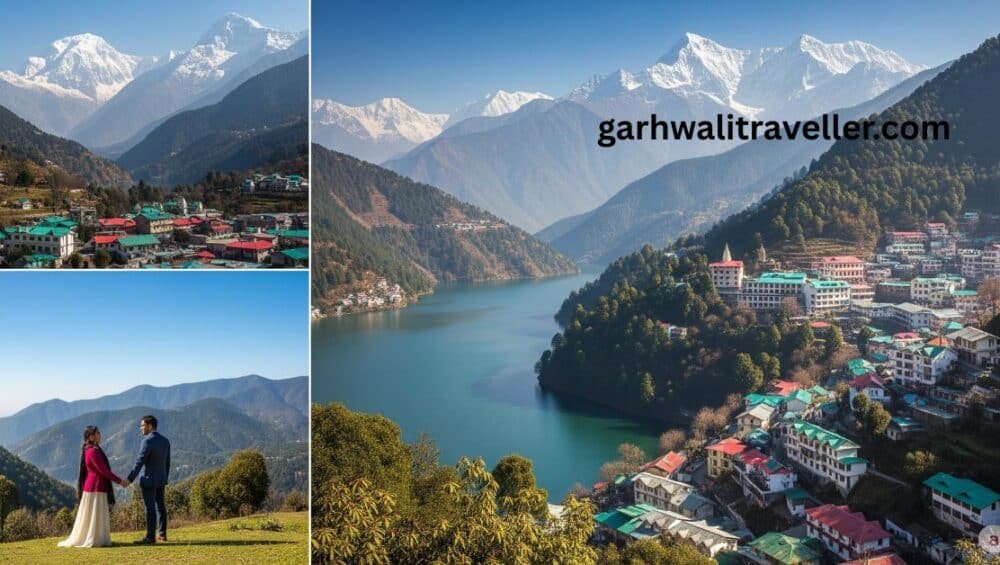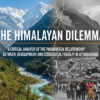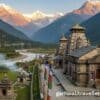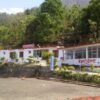Top 10 Places to Visit in Uttarakhand in January
Uttarakhand is a state in northern India known for its natural beauty and Hindu pilgrimage sites. It is located in the Himalayan mountain range and is home to several mountain peaks, including the Nanda Devi and Kamet. Winter in Uttarakhand is typically quite cold, with temperatures ranging from freezing to slightly above freezing in the lower elevations, and even colder in the higher elevations. Snowfall is common in higher elevations, and the region is popular with tourists who come to enjoy winter sports such as skiing and snowboarding. It is also a popular time for Hindu pilgrims to visit the state, as many temples and holy sites are located in the region. There are many winter destinations in Uttarakhand that you can visit during January.
During the winter months, Uttarakhand experiences a cold and dry climate, with temperatures ranging from 5°C to 15°C. The higher elevations, such as the hill stations of Dhanaulti and Mussoorie, can be quite chilly, with nighttime temperatures dropping below freezing. Snowfall is also common in higher elevations during the winter months. Despite the cold weather, this is a popular time for tourists to visit Uttarakhand, as the clear, dry air and low humidity make for great conditions for outdoor activities such as skiing and snowboarding.
There are plenty of beautiful locations where you can visit with your friends, family, and loved ones during this winter season.
1 – Auli
Auli is a popular ski resort located in the Chamoli district of Uttarakhand. It is situated at an altitude of 2,500-3,050 meters above sea level and is known for its beautiful ski slopes and stunning views of the Himalayas.
To reach Auli, you can fly to Jolly Grant Airport in Dehradun and then take a bus or hire a taxi to reach the resort. You can also take a train to Rishikesh or Haridwar and then take a bus or hire a taxi to Auli.
Some places to visit near Auli in winter are:
- Gurso Bugyal: This is a high-altitude meadow located near Auli, known for its breathtaking views of the Himalayas.
- Nanda Devi National Park: This is a UNESCO World Heritage Site located near Auli, known for its diverse flora and fauna.
- Joshimath: This is a small town located near Auli, known for its ancient temples and beautiful views of the Himalayas.
- Badrinath Temple: This is a famous Hindu temple located in the town of Badrinath, near Auli. It is one of the Char Dham pilgrimage sites in Hinduism.
- Valley of Flowers National Park: This is a UNESCO World Heritage Site located near Auli, known for its beautiful flowers and stunning views of the Himalayas.
2 – Chopta Valley
Chopta is a small valley located in the Rudraprayag district of Uttarakhand. It is situated at an altitude of 2,680 meters above sea level and is known for its beautiful views of the Himalayas.
To reach Chopta, you can fly to Jolly Grant Airport in Dehradun and then take a bus or hire a taxi to reach the valley. You can also take a train to Rishikesh or Haridwar and then take a bus or hire a taxi to Chopta.
Some places to visit near Chopta in the winter season are:
- Tungnath Temple: This is a famous Hindu temple located in the Chopta valley, known for its stunning views of the Himalayas. It is the highest Shiva temple in the world and is a popular destination for Hindu pilgrims.
- Deoria Tal Lake: This is a beautiful lake located near Chopta, known for its crystal clear waters and stunning views of the Himalayas.
- Chandrashila Peak: This is a popular trekking destination located near Chopta, known for its stunning views of the Himalayas.
3 – Ranikhet
Ranikhet is a hill station located in the Almora district of Uttarakhand. It is situated at an altitude of 1,829 meters above sea level and is known for its beautiful views of the Himalayas.
Ranikhet is a hill station in the Indian state of Uttarakhand. Some of its notable specialties include:
- Its picturesque location in the Kumaon Hills of the Himalayas
- The presence of the Military College of Telecommunication Engineering (MCTE), a premier technical institution of the Indian Army
- The Upat Kalika Temple, a temple dedicated to the goddess Kalika, is a popular pilgrimage site
- The Chaubatia Gardens, a group of fruit orchards and terraced gardens that offer a panoramic view of the surrounding mountains
- The Jhula Devi Temple, a temple dedicated to the goddess Jhula Devi, is another popular pilgrimage site
- Beautiful views of the Himalayas and a serene atmosphere make it popular among tourists, trekkers and nature lovers.
- Adventure activities like paragliding and skiing are also available in the region.
To reach Ranikhet, you can fly to Pantnagar Airport and then take a bus or hire a taxi to reach the hill station. You can also take a train to Kathgodam railway station and then take a bus or hire a taxi to Ranikhet.
Some places to visit near Ranikhet are:
- Jhula Devi Temple: This is a famous Hindu temple located near Ranikhet, known for its beautiful location and scenic views of the surrounding mountains.
- Binsar Mahadev Temple: This is a famous Hindu temple located near Ranikhet, known for its beautiful location and peaceful atmosphere.
- Chaubatia Orchards: This is a popular tourist destination located near Ranikhet, known for its beautiful gardens and delicious fruit orchards.
- Kumaon Regiment Centre Museum: This is a popular museum located in Ranikhet, known for its collection of military artifacts and memorabilia.
- Haidakhan Temple: This is a famous Hindu temple located near Ranikhet, known for its beautiful location and peaceful atmosphere.
4 – Binsar
Binsar is a small hill station located in the Almora district of Uttarakhand. It is situated at an altitude of 2,412 meters above sea level and is known for its beautiful views of the Himalayas.
To reach Binsar, you can fly to Pantnagar Airport and then take a bus or hire a taxi to reach the hill station. You can also take a train to Kathgodam railway station and then take a bus or hire a taxi to Binsar.
Some places to visit near Binsar in the winter season are:
- Binsar Mahadev Temple: This is a famous Hindu temple located near Binsar, known for its beautiful location and peaceful atmosphere.
- Binsar Wildlife Sanctuary: This is a popular tourist destination located near Binsar, known for its diverse flora and fauna.
- Jageshwar Temple: This is a group of ancient Hindu temples located near Binsar, known for their beautiful architecture and historical significance.
- Kasar Devi Temple: This is a famous Hindu temple located near Binsar, known for its beautiful location and peaceful atmosphere.
- Ranikhet: Ranikhet is a hill station located near Binsar, known for its beautiful views of the Himalayas and its many tourist attractions.
5 – Khirsu
Khirsu is a small hill station located in the Pauri Garhwal district of Uttarakhand. It is situated at an altitude of 1,700 meters above sea level and is known for its beautiful views of the Himalayas.
To reach Khirsu, you can fly to Jolly Grant Airport in Dehradun and then take a bus or hire a taxi to reach the hill station. You can also take a train to Rishikesh or Haridwar and then take a bus or hire a taxi to Khirsu.
Some places to visit near Khirsu in the winter season are:
- Khirsu National Park: This is a popular tourist destination located near Khirsu, known for its diverse flora and fauna.
- Chaukhamba View Point: This is a popular tourist destination located near Khirsu, known for its beautiful views of the Himalayas.
- Garija Temple: This is a famous Hindu temple located near Khirsu, known for its beautiful location and peaceful atmosphere.
- Lansdowne: Lansdowne is a hill station located near Khirsu, known for its peaceful and serene atmosphere and its many tourist attractions.
- Pauri Garhwal: Pauri Garhwal is a city located near Khirsu, known for its beautiful views of the Himalayas and its many tourist attractions.
6 – Munisiyari
Munisiyari is a small hill station located in the Pithoragarh district of Uttarakhand. It is situated at an altitude of 2,200 meters above sea level and is known for its beautiful views of the Himalayas. It is situated at the base of the Himalayas and is known for its natural beauty and adventure activities. Some of the notable features of Munsiari include:
- The Khaliya Top, a high-altitude mountain pass that offers stunning views of the Himalayas and the surrounding valley
- The Milam Glacier, one of the largest glaciers in the Kumaon Himalayas, is a popular destination for trekkers and mountaineers
- The Ralam Glacier, another glacier in the region that is also popular among trekkers
- The Nanda Devi National Park, a UNESCO World Heritage Site that is home to a wide variety of flora and fauna, including the Asiatic black bear, snow leopard, and musk deer
- The Ralam valley and Darkot village, are known for their natural beauty, traditional village lifestyle, trekking, and cultural experiences.
- It is also a base for various treks like Ralam Glacier trek, Khalia top trek, and Milam Glacier trek.
- Munsiari town is also known for its rich cultural heritage, with many temples and shrines dedicated to local deities, and many traditional festivals celebrated throughout the year.
To reach Munisiyari, you can fly to Pantnagar Airport and then take a bus or hire a taxi to reach the hill station. You can also take a train to Kathgodam railway station and then take a bus or hire a taxi to Munisiyari.
Some places to visit near Munisiyari in the winter season are:
- Birthi Falls: This is a beautiful waterfall located near Munisiyari, known for its stunning views and peaceful atmosphere.
- Martoli: Martoli is a small village located near Munisiyari, known for its beautiful views of the Himalayas and its peaceful atmosphere.
- Patal Bhuvaneshwar: This is a famous Hindu cave temple located near Munisiyari, known for its ancient architecture and historical significance.
- Chaukori: Chaukori is a hill station located near Munisiyari, known for its beautiful views of the Himalayas and its many tourist attractions.
- Bageshwar: Bageshwar is a city located near Munisiyari, known for its beautiful views of the Himalayas and its many tourist attractions. Read our complete travel guide on how to reach Bageshwar.
7 – Chamba
Chamba is a small hill station located in the Tehri Garhwal district of Uttarakhand. It is situated at an altitude of 1,073 meters above sea level and is known for its beautiful views of the Himalayas.
To reach Chamba, you can fly to Jolly Grant Airport in Dehradun and then take a bus or hire a taxi to reach the hill station. You can also take a train to Rishikesh or Haridwar and then take a bus or hire a taxi to Chamba.
Some places to visit near Chamba in the winter season are:
- Surkhanda Devi Temple: This is a famous Hindu temple located near Chamba, known for its beautiful location and peaceful atmosphere.
- Tehri Dam: This is a popular tourist destination located near Chamba, known for its beautiful views of the Himalayas and its man-made lake.
- Dhanaulti: Dhanaulti is a hill station located near Chamba, known for its beautiful views of the Himalayas and its many tourist attractions.
- Lansdowne: Lansdowne is a hill station located near Chamba, known for its peaceful and serene atmosphere and its many tourist attractions.
- Rishikesh: Rishikesh is a city located near Chamba, known for its beautiful views of the Himalayas and its many tourist attractions.
8 – Almora
Almora is a hill station located in the Kumaon region of Uttarakhand. It is situated at an altitude of 1,646 meters above sea level and is known for its beautiful views of the Himalayas and its rich cultural heritage.
Almora is also famous for its handicrafts, made by local artisans using traditional techniques. Some popular handicrafts from Almora include woolen shawls, woven baskets, and wooden toys.
In addition, Almora is known for its delicious cuisine, which is influenced by the local Kumaoni culture. Some popular dishes from Almora include bhang ki chutney, aloo ke gutka, and rasbhari.
Almora is also home to several temples and holy sites, which are popular with Hindu pilgrims. Some of the famous temples in Almora include the Nanda Devi Temple, Binsar Mahadev Temple, and Kasar Devi Temple.
To reach Almora, you can fly to Pantnagar Airport and then take a bus or hire a taxi to reach the hill station. You can also take a train to Kathgodam railway station and then take a bus or hire a taxi to Almora.
Some places to visit near Almora are:
- Binsar Mahadev Temple: This is a famous Hindu temple located near Almora, known for its beautiful location and peaceful atmosphere.
- Kasar Devi Temple: This is a famous Hindu temple located near Almora, known for its beautiful location and peaceful atmosphere.
- Nanda Devi Temple: This is a famous Hindu temple located in the town of Nanda Devi, near Almora. It is known for its beautiful location and peaceful atmosphere.
- Chitai Temple: This is a famous Hindu temple located near Almora, known for its beautiful location and peaceful atmosphere.
- Kausani: Kausani is a hill station located near Almora, known for its beautiful views of the Himalayas and its many tourist attractions.
9 – Dhanaulti
Dhanaulti is a hill station located in the Tehri Garhwal district of Uttarakhand. It is situated at an altitude of 2,286 meters above sea level and is known for its beautiful views of the Himalayas and its peaceful atmosphere.
Dhanaulti is known for its natural beauty, with forests of oak, pine, and rhododendron, and stunning views of the Himalayan peaks. It is a popular destination for tourists who come to enjoy the cool, refreshing mountain air and the peaceful atmosphere. Dhanaulti is also known for its eco-tourism initiatives, which include eco-friendly hotels and resorts, and opportunities for activities such as trekking, bird watching, and mountain biking.
To reach Dhanaulti, you can fly to Jolly Grant Airport in Dehradun and then take a bus or hire a taxi to reach the hill station. You can also take a train to Rishikesh or Haridwar and then take a bus or hire a taxi to Dhanaulti.
Some places to visit near Dhanaulti are:
- Surkhanda Devi Temple: This is a famous Hindu temple located near Dhanaulti, known for its beautiful location and peaceful atmosphere.
- Tehri Dam: This is a popular tourist destination located near Dhanaulti, known for its beautiful views of the Himalayas and its man-made lake.
- Chamba: Chamba is a small hill station located near Dhanaulti, known for its beautiful views of the Himalayas and its many tourist attractions.
- Lansdowne: Lansdowne is a hill station located near Dhanaulti, known for its peaceful and serene atmosphere and its many tourist attractions.
- Rishikesh: Rishikesh is a city located near Dhanaulti, known for its beautiful views of the Himalayas and its many tourist attractions.
10 – Kedarkantha Trek
Kedarkantha is a popular trekking destination located in the Uttarkashi district of Uttarakhand. It is situated at an altitude of 3,890 meters above sea level and is known for its beautiful views of the Himalayas and its varied terrain. It is known for its beautiful alpine meadows, snow-clad peaks, and panoramic views of the Himalayas. The trek can typically be completed in 7–8 days and is considered a moderate-difficult trek.
Here is a general outline of the procedure for the Kedarkantha trek:
- Arrive in Dehradun: The trek begins in Dehradun, a city in the state of Uttarakhand. Visitors should plan to arrive in Dehradun a day before the trek starts in order to acclimatize and prepare for the trek.
- Drive to Sankri: From Dehradun, trekkers will take a drive to Sankri, which is the starting point of the trek. The drive typically takes around 8-10 hours and passes through picturesque villages and forests.
- Trek to Juda Ka Talab: On the first day of the trek, trekkers will start from Sankri and head to Juda Ka Talab, which is the base camp for the trek. The trek usually takes around 4-5 hours and passes through dense forests.
- Trek to Kedarkantha Base Camp: On the second day, trekkers will continue their journey to Kedarkantha Base Camp, which is the second and last base camp. It is a relatively easy trek, taking around 3-4 hours.
- Trek to Kedarkantha summit: On the third day, trekkers will wake up early to make their way to the summit of Kedarkantha, the highest point of the trek. The trek to the summit is steep and can take around 4-5 hours.
- Trek back to Sankri: After the summit, trekkers will begin their descent back to Sankri, which takes about 7-8 hours.
- Drive back to Dehradun: After reaching Sankri, trekkers will take a drive back to Dehradun to end their trek.
It is important to note that the itinerary may vary from the different organizers, during winters the trek may become difficult due to snow and weather conditions and trekkers must be well-equipped and experienced. Hiring local guides and porters can make the journey more comfortable.
Some places to visit near Kedarkantha are:
- Har ki Dun: This is a popular trekking destination located near Kedarkantha, known for its beautiful views of the Himalayas and its varied terrain.
- Rishikesh: Rishikesh is a city located near Kedarkantha, known for its beautiful views of the Himalayas and its many tourist attractions.
- Uttarkashi: Uttarkashi is a city located near Kedarkantha, known for its beautiful views of the Himalayas and its many tourist attractions.
- Mussoorie: Mussoorie is a hill station located near Kedarkantha, known for its beautiful views of the Himalayas and its many tourist attractions.
- Dehradun: Dehradun is a city located near Kedarkantha, known for its beautiful views of the Himalayas and its many tourist attractions.




